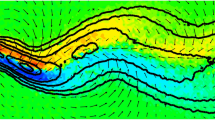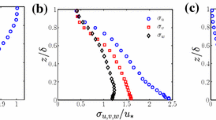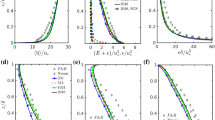Abstract
The average dispersion of a plume in the atmospheric boundary layer is strongly influenced by atmospheric turbulence. Atmospheric turbulence determines also concentration fluctuations due to turbulent meandering by large scale turbulent eddies and in-plume fluctuations, due to smaller scale eddies. Conversion of NO to NO2 in a plume is influenced by micro-scale mixing, due to the concentration fluctuation correlation % MathType!MTEF!2!1!+-% feaafeart1ev1aaatCvAUfeBSjuyZL2yd9gzLbvyNv2CaerbuLwBLn% hiov2DGi1BTfMBaeXatLxBI9gBaerbd9wDYLwzYbItLDharqqtubsr% 4rNCHbGeaGqiVu0Je9sqqrpepC0xbbL8F4rqqrFfpeea0xe9Lq-Jc9% vqaqpepm0xbba9pwe9Q8fs0-yqaqpepae9pg0FirpepeKkFr0xfr-x% fr-xb9adbaqaaeGaciGaaiaabeqaamaabaabaaGcbaWaa0aaaeaaca% qGobGaae4tamaaCaaaleqabaGaaeymaaaakiaab+eadaqhaaWcbaGa% ae4maaqaaiaabgdaaaaaaaaa!3AF4!\[\overline {{\rm{NO}}^{\rm{1}} {\rm{O}}_{\rm{3}}^{\rm{1}} } \] and macro-scale mixing, the mixing in of ambient air containing O3 into the plume.
The study of turbulent meandering, in-plume fluctuations, microscale and macro-scale mixing will contribute to a better understanding of concentration fluctuations in general.
Similar content being viewed by others

References
P.J.H. Bulltjes “A comparison between chemically reacting plumes and wind tunnel experiments” 12th Int. Tech. Meeting on Air Pollution and its Application, Palo Alto U.S.A. (1981).
P.J.H. Builtjes e.a. “Chemical Reactive plumes — Field experiments and Modelling” 7th Clean Air Congress, Sydney, Australia (August 1986).
N.J. Duijm and P.J.H. Builtjes “Measurements of concentration fluctuations” Third Int. Workshop on Wind & Water tunnel Modelling of atmospheric flow & Dispersion, Lausanne (September 15–17, 1986).
J.E. Fackrell and A.G. Robins “Concentration fluctuations and fluxes in plumes from point sources in a turbulent boundary layer” J. Fluid Mech. 117, 1–26, (1982).
P.G. Georgopoulos & J.H. Seinfeld “A mathematical model for the variance of plume concentrations” 7th Symp. on Turbulent Diffusion A.M.S. Boulder (1985).
S.R. Hanna “Concentrations fluctuations in a smoke plume” Atm. Env. 18, 6, 1091–1106, (1984).
J.O. Hinze “Turbulence” McGraw Hill, New York (1975).
C.D. Jones“On the structure of instantaneous plumes in the atmosphere” Journal of Hazardous Materials, 7, 87–112, (1983).
M. Lusis “Mathematical Modelling of Chemical Reactions in a plume” 7th Int. Tech. Meeting on Air Pollution and its Application (1976).
Mueller, S.F. and L.M. Reisinger “Measured plume width versus sampling time: A look beyond 10 kilometers” Atm. Env. 20, 5, 895–900 (1986).
Ooms G. and A.P. Mahieu “The plume path of vent gases heavier than air” First Int. Sym. Loss Prevention Safety, The Hague, (May 1974).
Author information
Authors and Affiliations
Rights and permissions
About this article
Cite this article
Builtjes, P.J.H., Talmon, A.M. Macro- and micro-scale mixing in chemical reactive plumes. Boundary-Layer Meteorol 41, 417–426 (1987). https://doi.org/10.1007/BF00120455
Issue Date:
DOI: https://doi.org/10.1007/BF00120455



